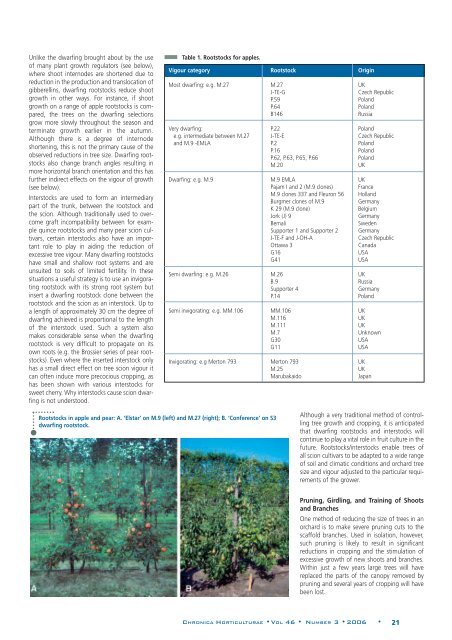Acta Horticulturae
Acta Horticulturae
Acta Horticulturae
Create successful ePaper yourself
Turn your PDF publications into a flip-book with our unique Google optimized e-Paper software.
Unlike the dwarfing brought about by the use<br />
of many plant growth regulators (see below),<br />
where shoot internodes are shortened due to<br />
reduction in the production and translocation of<br />
gibberellins, dwarfing rootstocks reduce shoot<br />
growth in other ways. For instance, if shoot<br />
growth on a range of apple rootstocks is compared,<br />
the trees on the dwarfing selections<br />
grow more slowly throughout the season and<br />
terminate growth earlier in the autumn.<br />
Although there is a degree of internode<br />
shortening, this is not the primary cause of the<br />
observed reductions in tree size. Dwarfing rootstocks<br />
also change branch angles resulting in<br />
more horizontal branch orientation and this has<br />
further indirect effects on the vigour of growth<br />
(see below).<br />
Interstocks are used to form an intermediary<br />
part of the trunk, between the rootstock and<br />
the scion. Although traditionally used to overcome<br />
graft incompatibility between for example<br />
quince rootstocks and many pear scion cultivars,<br />
certain interstocks also have an important<br />
role to play in aiding the reduction of<br />
excessive tree vigour. Many dwarfing rootstocks<br />
have small and shallow root systems and are<br />
unsuited to soils of limited fertility. In these<br />
situations a useful strategy is to use an invigorating<br />
rootstock with its strong root system but<br />
insert a dwarfing rootstock clone between the<br />
rootstock and the scion as an interstock. Up to<br />
a length of approximately 30 cm the degree of<br />
dwarfing achieved is proportional to the length<br />
of the interstock used. Such a system also<br />
makes considerable sense when the dwarfing<br />
rootstock is very difficult to propagate on its<br />
own roots (e.g. the Brossier series of pear rootstocks).<br />
Even where the inserted interstock only<br />
has a small direct effect on tree scion vigour it<br />
can often induce more precocious cropping, as<br />
has been shown with various interstocks for<br />
sweet cherry. Why interstocks cause scion dwarfing<br />
is not understood.<br />
Table 1. Rootstocks for apples.<br />
Vigour category Rootstock Origin<br />
Most dwarfing: e.g. M.27 M.27 UK<br />
J-TE-G<br />
Czech Republic<br />
P.59 Poland<br />
P.64 Poland<br />
B146<br />
Russia<br />
Very dwarfing: P.22 Poland<br />
e.g. intermediate between M.27 J-TE-E Czech Republic<br />
and M.9 -EMLA P.2 Poland<br />
P.16 Poland<br />
P.62, P.63, P.65, P.66<br />
Poland<br />
M.20 UK<br />
Dwarfing: e.g. M.9 M.9 EMLA UK<br />
Pajam I and 2 (M.9 clones) France<br />
M.9 clones 337 and Fleuron 56 Holland<br />
Burgmer clones of M.9<br />
Germany<br />
K 29 (M.9 clone)<br />
Belgium<br />
Jork (J) 9<br />
Germany<br />
Bemali<br />
Sweden<br />
Supporter 1 and Supporter 2 Germany<br />
J-TE-F and J-OH-A<br />
Czech Republic<br />
Ottawa 3<br />
Canada<br />
G16<br />
USA<br />
G41<br />
USA<br />
Semi dwarfing: e.g. M.26 M.26 UK<br />
B.9 Russia<br />
Supporter 4<br />
Germany<br />
P.14 Poland<br />
Semi invigorating: e.g. MM.106 MM.106 UK<br />
M.116 UK<br />
M.111 UK<br />
M.7 Unknown<br />
G30<br />
USA<br />
G11<br />
USA<br />
Invigorating: e.g Merton 793 Merton 793 UK<br />
M.25 UK<br />
Marubakaido<br />
Japan<br />
Rootstocks in apple and pear: A. ‘Elstar’ on M.9 (left) and M.27 (right); B. ‘Conference’ on S3<br />
dwarfing rootstock.<br />
Although a very traditional method of controlling<br />
tree growth and cropping, it is anticipated<br />
that dwarfing rootstocks and interstocks will<br />
continue to play a vital role in fruit culture in the<br />
future. Rootstocks/interstocks enable trees of<br />
all scion cultivars to be adapted to a wide range<br />
of soil and climatic conditions and orchard tree<br />
size and vigour adjusted to the particular requirements<br />
of the grower.<br />
Pruning, Girdling, and Training of Shoots<br />
and Branches<br />
One method of reducing the size of trees in an<br />
orchard is to make severe pruning cuts to the<br />
scaffold branches. Used in isolation, however,<br />
such pruning is likely to result in significant<br />
reductions in cropping and the stimulation of<br />
excessive growth of new shoots and branches.<br />
Within just a few years large trees will have<br />
replaced the parts of the canopy removed by<br />
pruning and several years of cropping will have<br />
been lost.<br />
CHRONICA HORTICULTURAE •VOL 46 • NUMBER 3 • 2006 • 21
















